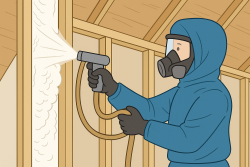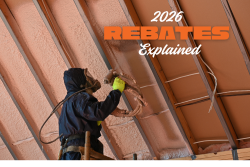Home safety is a big concern for many people in Waterloo. We install smoke detectors, buy fire extinguishers, and pay close attention to our electrical wiring. But there’s one important part of home safety that sometimes gets overlooked: insulation. Many people don’t realize that the material inside their walls can play a major role in slowing down a fire. In this blog, we’ll talk about why insulation matters for fire safety, how it helps protect your home, and which types of insulation can work best. We’ll also look at some local rebate programs that can make your upgrades more affordable.
1. Understanding Fire Risks in Waterloo
Waterloo’s climate can be quite cold in the winter, and our homes are often sealed up tightly for warmth. While a snug home can be great for comfort, it also means any fire that starts inside may spread faster if the house is not built or protected well. Many homeowners in our area have older homes, and some of these houses still have outdated or damaged insulation. If a fire starts, insulation can either slow it down or help it spread—depending on what kind of insulation is in place and how well it is maintained.
2. How Insulation Affects Fire Safety
Insulation isn’t just about keeping you warm in winter and cool in summer. It also affects how fast a fire can move from one room to another. Some insulation materials are more resistant to heat, while others catch fire or melt more easily. When insulation can stand up to higher temperatures, it may slow the fire’s movement. Every second counts during a house fire, and slowing the flames can give your family time to exit safely and call for help. This is where fireproofing measures come into play.
3. What Is Fireproofing?
Fireproofing refers to the process of making a building or material more resistant to fire. While “fireproof” might sound like it can completely stop a fire, the truth is that no house can be 100% protected against flames. However, proper fireproofing can reduce the speed at which fire spreads or lower the intensity of the heat. This can involve using building materials designed to withstand flames, adding special coatings to structural elements, and choosing insulation that has fire-resistant qualities.
4. The Role of Spray Foam Insulation
You’ve probably heard of fiberglass or cellulose insulation, which are common in many older Waterloo homes. These materials can work fine for normal insulation needs, but they don’t always provide the best resistance to heat and flames. That’s where Spray Foam Insulation comes in.
Spray Foam Insulation is applied as a liquid that expands into a foam, filling up spaces and sealing cracks. It often includes fire-retardant chemicals that can help slow down or reduce the spread of flames. This type of insulation also helps block air flow. A lack of air means fires have less oxygen to feed on, which can be a big advantage during an emergency. On top of that, spray foam’s tight seal helps reduce drafts and lower energy bills, making it a dual-purpose solution for both comfort and safety.
5. Comparing Different Insulation Materials
Before deciding to upgrade, it’s good to know the basic differences between common types of insulation:
- Fiberglass: While fiberglass itself doesn’t burn easily, the paper backing can be flammable. Fiberglass can also melt when it’s exposed to very high heat. It’s usually cheaper, which is why many older homes rely on it.
- Cellulose: Made from recycled paper, cellulose is treated with fire-retardant chemicals. It can slow fire spread to some extent, but it might still smolder if exposed to flames for a long time. Over the years, the chemicals can wear off and lower its fire resistance.
- Mineral Wool: Also known as rock wool or slag wool, mineral wool has a high melting point. It’s quite resistant to fire and does a good job blocking sound, but it might cost more than fiberglass or cellulose.
- Spray Foam Insulation: This modern option provides an airtight seal and is often mixed with chemicals that slow burning. Since it keeps out air, it also removes one element that helps fires grow. It can be more expensive upfront, but many people find the long-term benefits worth it.
6. Code Requirements and Local Standards
In Ontario, our building codes address fire safety and energy efficiency. The code sets minimum requirements for insulation in different parts of a home, such as the attic, walls, and basement. It also has rules for fire-resistant barriers and other safety measures. If you live in Waterloo, you’ll want to make sure any insulation upgrades meet or surpass these codes. Hiring a professional who understands local rules will help you avoid problems later. A good contractor will suggest the best type of insulation for both energy savings and fire resistance.
7. Saving Money and Increasing Safety
Upgrading insulation is not just a cost—it’s an investment in your home and your peace of mind. When you improve the insulation, you’re likely to see lower heating and cooling bills because your HVAC system won’t have to work as hard. At the same time, choosing an insulation option that improves fire safety can be invaluable if a fire ever does occur. It’s a smart way to tackle two major concerns with a single project. People in Waterloo often have to crank up the heat in winter, so any measure that cuts down on energy use can make a big difference in monthly bills.
8. Rebate Programs: IESO Home Renovation Savings Program
One of the biggest barriers to upgrading insulation is the cost. The good news is that homeowners in Waterloo can look into rebate programs that may offset some of that expense. A great example is the IESO Home Renovation Savings Program. This program offers incentives for making energy-efficient changes to your home, including improving or replacing old insulation.
If you qualify, you can get money back, which eases the financial burden of buying and installing new materials. These rebates are designed to encourage people to use less energy and make homes safer and more efficient. By taking advantage of the program, you can reduce the overall project cost, leaving more room in your budget for other home improvements or safety devices.
9. Practical Fire Safety Tips
Of course, insulation is just one part of a bigger fire safety plan. Even if you install the best fire-resistant materials, you still need to take everyday precautions:
- Check Smoke Alarms: Make sure you have working smoke alarms on every floor. Test them monthly and change batteries at least once a year.
- Have a Plan: Everyone in your household should know how to get out quickly if a fire occurs. Plan routes and practice fire drills.
- Store Flammable Items Carefully: Keep things like gasoline, paint, and cleaning supplies away from open flames or high heat.
- Inspect Wiring and Appliances: Old or damaged wiring is a major cause of house fires. If your appliances or cords look frayed or worn, replace them.
- Stay Alert in the Kitchen: Cooking is a common source of household fires. Never leave the stove unattended for long, and keep flammable items away from burners.
When you add these practices to an insulation upgrade, you can significantly lower the risk of a serious fire in your Waterloo home.
10. Making the Final Decision
Choosing the right insulation for your home involves thinking about cost, energy efficiency, and safety. While all insulation materials have some level of fire risk, using products with higher fire resistance gives you an edge in an emergency. That’s why many people are turning to modern solutions like Spray Foam Insulation. It not only helps cut down on drafts and high energy bills but also offers improved protection against fire spread. If you pair your insulation upgrade with good fireproofing techniques—such as using fire-resistant drywall or coatings—you’re going the extra mile in keeping your home and family safe.
Remember to take advantage of local incentives like the IESO Home Renovation Savings Program if you qualify. By lowering the upfront cost, these programs make it more appealing to choose higher-quality materials that last longer and give you peace of mind. Waterloo is a wonderful place to live, and it’s worth investing in your home to keep it both comfortable and safe.
When you look at everything insulation can do—save energy, reduce drafts, and slow down fire—it becomes clear that this is one home improvement you don’t want to ignore. Whether you’re building a new house or updating an older one, consider how the right insulation can protect your family and property for years to come. A bit of planning and the right materials can go a long way toward reducing fire risks and keeping everyone warm and secure.
.png)
















